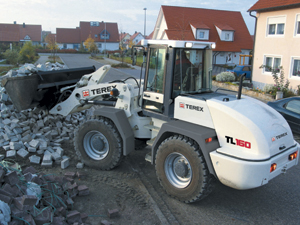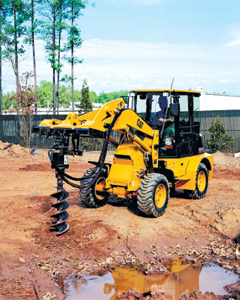Get Attached to Preventive Maintenance
As wheel loaders come down in size, they are also adapting the equipment traits of compact machines. Today’s compact wheel loaders take attachments, which means they utilize quick-attach plates to switch implements in and out. Regular care of your loader and its attachments can prevent the need for costly repairs or replacements. By following a few simple steps, you can help your wheel loader continue to do what it is supposed to do — make you money.
An Inspection a Day Keeps the Mechanic Away
No matter which attachment you’re using on your wheel loader — a bucket, sweeper, forks, rotary drum, snow blade, grapple bucket, fork grapple, tree mover, auger or a lift hook — your loader’s attachments need to be inspected before and after each use. Regular care of your attachments’ components will keep costs down and help you achieve a healthy bottom line.
 “Downtime to fix or replace an attachment is costly to owners and operators. Simply handling the little maintenance tasks every day can help you avoid this,” says Bill Parker, wheel loader product manager for Terex Construction Americas. “Preventive maintenance saves money.”
“Downtime to fix or replace an attachment is costly to owners and operators. Simply handling the little maintenance tasks every day can help you avoid this,” says Bill Parker, wheel loader product manager for Terex Construction Americas. “Preventive maintenance saves money.”
According to Parker, the best person to complete the attachment’s maintenance checks is you, the operator — the one person who knows the most about how and when the attachment was used, as well as the loader’s particular sounds and performance.
“Like your wheel loader’s daily maintenance routine,” says Parker, “your attachments inspection should be simple and easy to follow.” Three simple steps will keep your attachments working for a long time.
Step 1: Check for any leaks in the attachment’s hoses and fittings. Before each use, inspect the attachment’s hoses for cracks and make sure all shielding is in place. Check the fittings to ensure that they are not loose. To guarantee peak performance from your loader and your attachments, make sure both the hoses and fittings are clean and free of contaminants.
Step 2: Make sure all of the attachment’s critical points are lubricated and functioning properly. Parker recommends washing down the attachment after use to remove any dirt, sand, dust or other jobsite contaminants that accumulate during operation. Once the attachment is clean, lubricate according to the manufacturer’s guidelines.
Step 3: Inspect your loader’s attachment system to make sure the locking mechanism is operating properly. Many loaders are designed with a quick-attach system or a universal coupler, which is the same technology often used on skid steers. These systems are either manual or hydraulic coupler, depending on the particular loader manufacturer, explains Parker. Both systems have a spring-loaded locking mechanism design. To ensure easy locking and unlocking with the attachment, it is important that the locking mechanism is not stiff or bent. A quick check when changing out attachments is the best way to determine if there has been any damage to the system.
Don’t Ignore the Obvious
Parker advises that using common sense goes a long way in preventing damage and increasing the longevity of your investments.
“Operators need to be aware of their surroundings when running a wheel loader, especially while operating particular attachments,” says Parker. “For example, when an operator is using a rotary drum attachment, it’s critical to know where the discharged snow will go.
“Operators should also be familiar with the existing landscaping and infrastructure,” continues Parker, “as well as how much area the loader needs to operate when equipped with an attachment. For example, when the loader is equipped with tree moving equipment, an operator will need to account for the height of the tree in relation to the attachment when working in the vicinity of power lines, buildings and other trees. As always, it’s also critical for operators to ensure that bystanders are clear.”

“If the attachment system and/or the attachment are hydraulically operated,” says Parker, “routine maintenance on the hydraulic system is critical. It is important to understand and follow both the loader manufacturer’s and the attachment manufacturer’s service recommendations.”
Parker recommends that a daily walk-around of your wheel loader to spot wear and tear should include a check of the attachment, as well. This is especially important if the attachment stays on the machine in long-term applications. “Attachments have wear points too,” says Parker. “For example, on buckets the edges will wear thin over time and on sweepers the bristles will wear out. These wear points must be fixed or replaced as needed to keep the attachment working properly.” Of course, damage incurred to both the attachment and the wheel loader during daily operation must be addressed immediately.
“Keep an eye on which components on the machine and attachments are showing signs of wear, analyze the trends and make changes to operating procedures as necessary to avoid these wear patterns,” says Parker. “Too often, the littlest things can be indications of bigger issues — the warning signs should never be ignored.”
Parker concludes: Regular maintenance of not only your wheel loader but also your loader’s attachments, pays for itself by increasing the usable life of your investments. So, as you’re looking for simple ways to make more money without increasing your costs — get attached to preventive maintenance.
Amber Reed is a technical writer for Performance Marketing, based in West Des Moines, Iowa.

Comments are closed here.